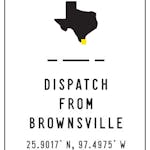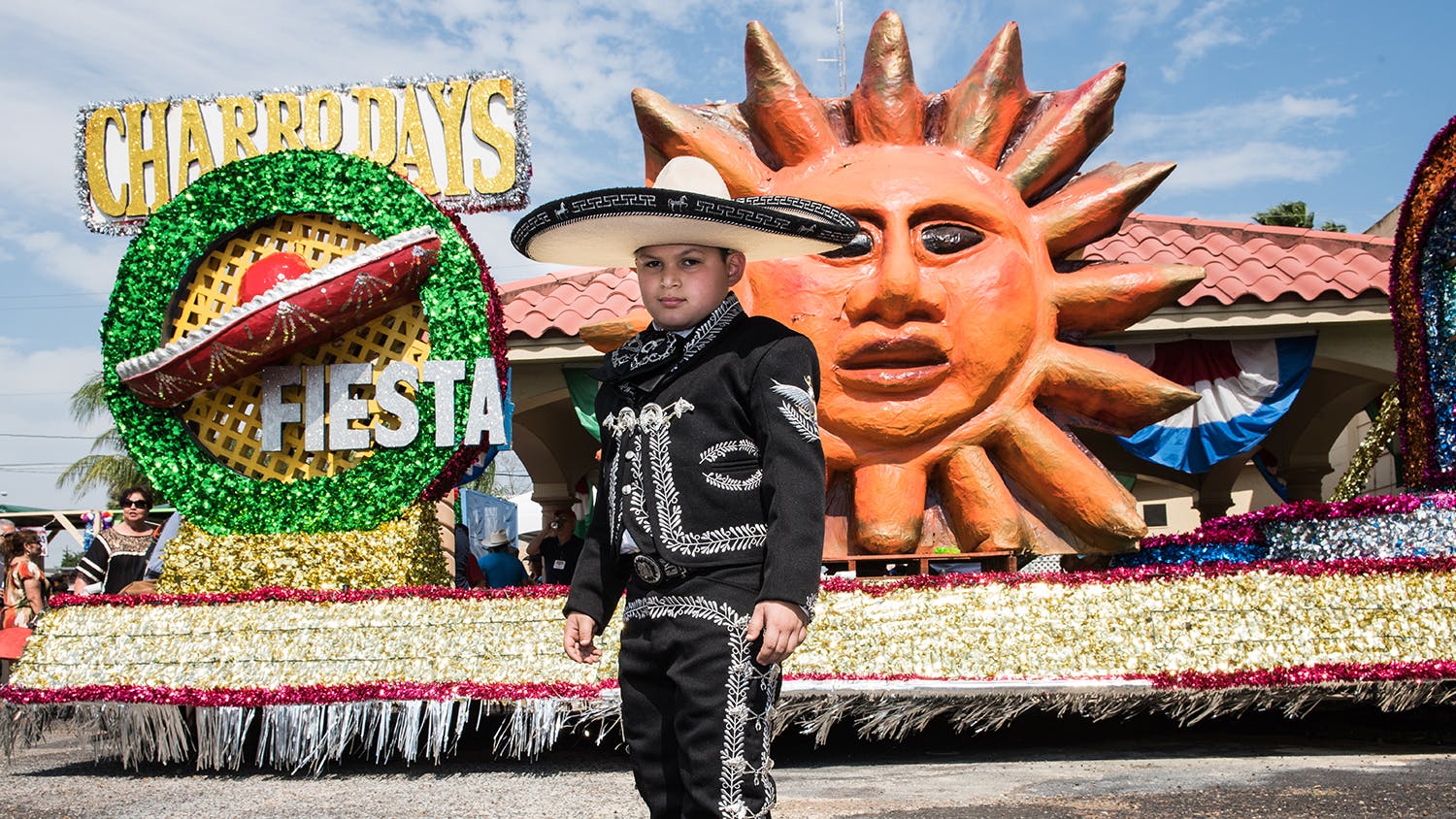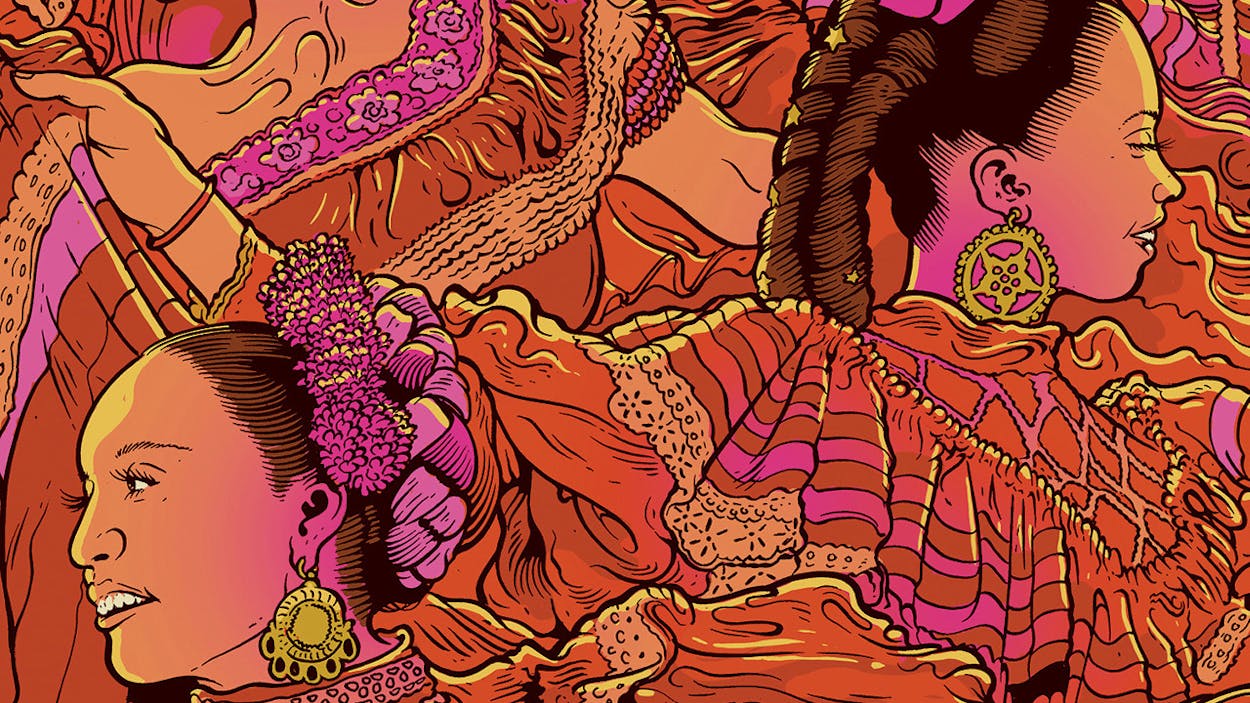 Early one warm morning in February, a smiling man in a baseball cap walked into the lobby of a Brownsville hotel holding a blue birdcage with ten white doves. He wore sporty sunglasses and a bright-red T-shirt, which bore the image of a blue river and a truss bridge above it, with the phrase “It Takes BOTH SIDES to Build a Bridge” flanked by American and Mexican flags.
Early one warm morning in February, a smiling man in a baseball cap walked into the lobby of a Brownsville hotel holding a blue birdcage with ten white doves. He wore sporty sunglasses and a bright-red T-shirt, which bore the image of a blue river and a truss bridge above it, with the phrase “It Takes BOTH SIDES to Build a Bridge” flanked by American and Mexican flags.
Several people in matching shirts greeted him and the birds enthusiastically. A handful of police officers also milled about in the lobby, while other men and women, dressed in Mexican charro suits and loud folkloric dresses, moved in and out of a room that smelled of French toast and hotel eggs. “¡Qué guapa!” one woman exclaimed as another arrived in a long flowered dress and bows on her head. “Beau-tiful!” A couple of young businessmen with laptops watched the small spectacle, bemused. “I’m so confused right now,” one of them remarked, laughing. “There’s cops, doves, T-shirts of bridges . . . ”
For locals, there was no confusing what a group of full-grown adults dressed as Mexican horsemen and señoritas signaled. This was Charro Days Fiesta, the city’s most exciting event of the year. For the people in red T-shirts and their costumed colleagues—a civic group called the Mr. Amigo Association, one of three major organizations behind the festivities—the weeklong celebration was the culmination of ten months of hard organizing work. There had been various parties since Sunday, but this day, Thursday, the most emblematic event took place. In a ceremony called Hands Across the Bridge, dignitaries from both sides of the border, accompanied by a special celebrity Mexican guest dubbed “Mr. Amigo,” would meet on a stage on the city’s primary international bridge and exchange abrazos while proclaiming to the world the significance of their deep, long-running friendship. There would be speeches in English and Spanish, children from Brownsville and Matamoros would shyly exchange gifts, and then the ten white doves would be released as a final sign of binational peace. It was always the same program, with many of the same people, but somehow the ritual always managed to inspire an authentic sense of pride and, sometimes, even some goose bumps.
It was not lost on anyone, though, that if Charro Days was all about reveling in international symbols, this was a particularly symbolic year. Not only was the event celebrating its eightieth anniversary, but it was also taking place after more than a year of fervid campaign talk about a dangerous, out-of-control Mexican border and on the heels of President Trump’s executive order calling for “the immediate construction of a physical wall” to keep out terrorists, traffickers and unlawful immigrants. Brownsville already had a wall along many of its stretches, built during the Bush administration, only officials then had referred to it euphemistically as a “fence”—which technically it was, if fences can be eighteen feet tall and made of steel with concrete foundations. Still, locals had long called it the wall, since they felt that that was how it was meant to serve; now at least authorities were using the same language.

The lobby doors slid open and three congressmen walked in: Beto O’Rourke, from El Paso, who would soon announce his run for the Senate; Vicente Gonzalez, a lawyer in McAllen who had recently been sworn in for his first term; and Brownsville’s own Filemon Vela, who had made headlines with an open letter to Trump after the candidate had suggested that Mexicans were rapists and cartel members. “Mr. Trump, you’re a racist,” Vela seethed, “ and you can take your border wall and shove it up your ass.” Now, wearing a blue guayabera, he strode in to shake hands with this year’s Mr. Amigo: Fernando Landeros, who had founded Teletón México and Teleton USA, a foundation that puts on massive 24-hour broadcast telethons to fund rehabilitative hospitals for children with disabilities. The mild-mannered Landeros mused out loud on the fact that the brown suede cowboy jacket he’d donned to fit in was from the wrong region in Mexico. The jacket was a “pachuqueña,” he’d been told, not a “cuera tamaulipeca.”
The Mr. Amigo buses were ready, and it was time to go. Downtown, at the Gateway International Bridge, school-age girls dressed in sequined china poblana dresses waited with the white-haired mayor of Brownsville, Tony Martinez, who wore jeans and a real cuera from Tamaulipas, in black. When it was time, members of the Mexican delegation—men and women in fringed leather jackets of various colors—strode from their end of the bridge as their Texas peers, looking just a tiny bit less stately in bright ruffled dresses and mariachi-like suits with satin bow ties, walked toward them from their end. The two parties met at the center, taking seats on the stage to face a small audience of invited guests and reporters. “Today we get to show the world how we live together, Brownsville and Matamoros, on the border, by the sea,” began the emcee solemnly. In the foreground stood the rust-brown fence, the gentle waters of the Rio Grande lapping beneath it.
Martinez, the mayor, waxed poetic about the nature of the borderland. “Whether you call it El Río Bravo or the Rio Grande River, the water that touches the banks of our nation is a reminder that where boundaries attempt to separate us, we must build bridges,” he said. His sentiments were echoed in short order by Jesús de la Garza Díaz del Guante, the jovial and mustachioed mayor of Matamoros, who followed with his own speech. “If these festivities have always sought to bring us together,” Díaz del Guante said, “the situation today makes us celebrate them with more conviction, with more fraternity, with the most strength possible, because our festivals offer precisely the confirmation that we come from one same origin.” He went on for a while—about sharing languages and prosperity and culture—until a few bored children began to cry, and he realized he was reading a page he had already read. “Don’t tell me I’m done?” he said, as the crowd roared with laughter.
After the three congressmen delivered their own messages, about how it was time for the region to stand up for itself, the caged doves were brought to the stage. The birds, squirming nervously, were placed in the hands of chosen representatives, who, as a mariachi began to play and the president of the Mr. Amigo Association nodded his head, released them into the air. Spectators squealed. Two or three flew straight into reporters’ video cameras and flapped around, stunned—an apt last metaphor for the political moment—until the journalists shooed them with their notepads and they too escaped.
The concept of sister cities was popularized in the fifties, when President Dwight D. Eisenhower proposed creating relationships between American and foreign cities as a way of promoting diplomacy and diminishing future world conflict. On the Texas-Mexico border, however, this idea has been a reality going back as far as 1848, when the international boundary was drawn and cities on opposite sides of the river found they needed each other for survival. With their respective capitals far away and their national leaders disinterested in the day-to-day happenings along the new border, cities like Brownsville and Matamoros relied instead on their counterpart across the river—for workers, for goods and services, and for the kind of mutual understanding that a distant federal government could not offer.
The fates of Matamoros and Brownsville, then, have long risen and fallen together. Matamoros was founded by Spaniards, while Brownsville was born of the war against Mexico, which was launched on its riverbanks, but in the decades that followed, they depended on each other to weather frontier raids, the American Civil War, a French attack on Mexico, and the arrival of railroads and irrigation. According to Charro Days in Brownsville, a book by historians Anthony Knopp, Manuel Medrano, and Priscilla Rodríguez, it was at the end of the Great Depression that the festival came to life. In 1937, a Brownsville businessman, inspired by Mission’s Citrus Fiesta, cooked up the idea as a way to lift his city’s spirits and draw tourist dollars into the sagging economy. It was a Mardi Gras for the border, a pre-Lenten series of fiestas that kicked off in February 1938 and was intended to commemorate Brownsville’s Mexican heritage, as typified by the charro, “a fancy-dress Mexican version of the rodeo cowboy.” (Though in fact the influence goes the other way: the Texas cowboy borrowed his skills and dress from the Mexican vaquero, who herded cattle and wild horses on horseback for generations. The charro is the showman and the vaquero is the ranch worker.) Though Mexican culture permeated the city, note the historians in the book, it did “less so on the upper reaches of Brownsville society,” which was part Anglo. Charro Days would change that.
The fiestas became a national and international sensation. Observers from far away were captivated by the Mexican costumes, the men sporting beards (a mandatory requirement; men caught without one would be taken to “court” and forced to pay a symbolic fine), and the grand parades, with their horse-drawn floats, military bands, and soldiers in original Civil War uniforms. The first year, Charro Days was covered in National Geographic, and the next year, Paramount and Universal featured scenes from the celebration in movie theaters across the country. Time and Life also published photo spreads, and radio networks broadcast news of the elegant balls nationally. Texas governor Price Daniel would eventually proclaim Charro Days “a major contribution to the Good Neighbor Policy, benefitting all peoples in the Western Hemisphere.”
By the fifties, the celebration included a day when the border was declared open for anyone to cross freely, in either direction, regardless of citizenship. “The parade would start here and go across the bridge into Matamoros,” Mayor Martinez told me, sitting in his law office by the county courthouse. Behind him, historical photos of Brownsville hung on the walls. “ ‘Día libre,’ they used to call that day, and nobody had to show any papers. Then, times changed, and we couldn’t do that anymore. People from Matamoros still come in this direction, but we no longer go across.”
Indeed, as the security apparatus on the border grew and drug cartels in Mexico become more violent, American agents increased their vigilance and demanded documents more often. Wait times on the bridge lengthened. The Charro Days Fiesta board of directors voted to not let their floats cross into Matamoros for the parade; there was insurance coverage to worry about, as well as security concerns for participants, many of whom were children. The Mexican floats and bands and dignitary vehicles began having to coordinate better with the Department of Homeland Security. “It’s kind of difficult for Matamoros to bring over floats, though I know they had one this year because I saw it,” said Lucy Escamilla, the event’s head organizer. “It’s hard for them to pass through customs. We meet here about two weeks before the event with the city, the police department, and customs, and there are a lot of questions back and forth. ‘What time are you gonna be there?’ ‘Who are the people?’ ‘Make sure they have their passports.’ ”
Borders are powerful symbols, and to live on the edge of anything—culturally, geographically—is to know and understand yourself in relation to the other side. If the pictures and language of cultural integration were what fascinated the world about Brownsville in the forties and fifties, these days, what seems louder and more powerful is the Washington discourse around border insecurity. “What Charro Days allowed us to do this year,” said Martinez, “is show the world that these two communities are actually secure. There may be cartel activity in Matamoros, yes, but we are walking hand in hand, which is why Hands Across the Bridge has been so successful. Because true friends don’t leave when times are tough. That’s what we’re trying to tell people: these are our friends, these are our families. We’re with them and behind them, trying to resolve the situation brought about by the rhetoric in Washington. We have to respectfully deal with the country of Mexico and its citizens. You’re not going to take away their dignity—we share that sentiment here.”

This year, the Grand International Parade, the crowning moment of Charro Days, began as it always does, on a Saturday at half past noon, with a solemn succession of marching-school junior ROTC programs. Behind them followed an exercise in community relations by the Department of Homeland Security: a protracted line of cars, SUVs, and agents on horseback, as well as a horse trailer, a patrol boat, and even a slow-moving white flatbed trailer, which was decorated with paper flowers and gold metallic fringe and was ferrying an animated band of baseball-capped customs and Border Patrol agents who busted out “El Tao Tao,” a popular bouncy cumbia, on accordions and guitars, as police sirens blared in the background.
For two hours, there would be the usual: the glittering floats with dancers; the vaqueros and charros on their beautiful, prancing horses; the Shriners doing figure eights in noisy, tiny cars; the convertibles with politicians and their families waving like local heroes; the clowns and mascots strolling goofily and posing for photos with children in the crowd. There were middle and high school bands playing traditional songs from Mexico, and the familiar calls on the sidewalk for “caaan-dy appp-les, fiiif-ty ceeents!” and the desperate collective yearning among spectators in the early South Texas heat for a Coke or a bottle of water. The acts were the same ones every year, but the familiarity felt good. Charro Days, after all, is about reunion, about ritualistic repetition, the warm feelings that come from knowing a place and a way of being that doesn’t change too much over time. To watch a Charro Days parade is to be reaffirmed in who you are, to know that you belong somewhere and that that somewhere is a pretty special place.
“Growing up, I thought Charro Days was a national holiday,” joked Mike Hernandez, the owner of an auto-leasing company, who was watching the parade with a group of Aggies, cheering on A&M chancellor John Sharp and a squadron of the school’s Corps of Cadets in their first appearance. He now invests some of his wealth in Brownsville to support low-income communities. “I’m a better person being from Brownsville, because I’m literate in two cultures,” he said. “I have a very different idea of how to address the immigration question.” He paused for a moment, growing reflective, then continued. “I’m a better person for knowing this culture, and so are you.”
- More About:
- Brownsville







